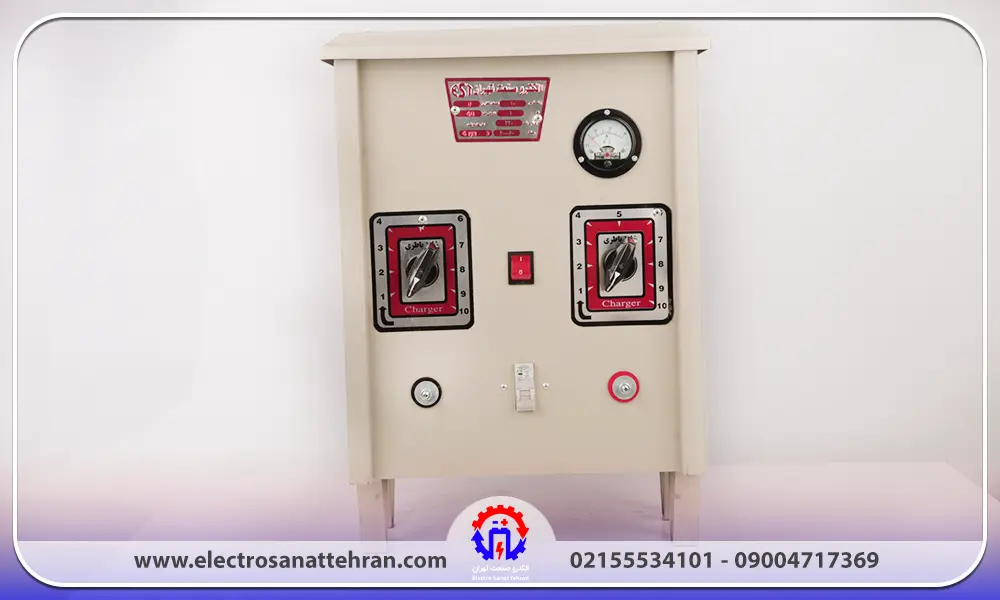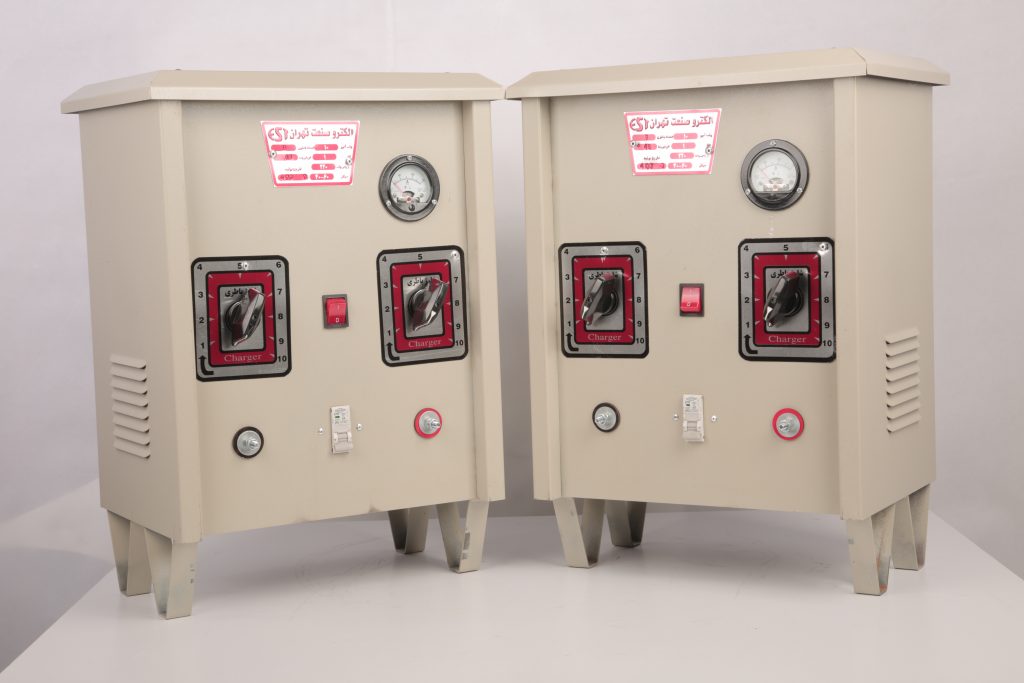Guide to buying and working with a car battery charger

It is better to know that all car batteries are rechargeable and the best way to charge a car battery at home is to use a car battery charger. With these types of chargers, you can easily charge your car battery (acid battery-dry battery-atomic battery) at home, garage or anywhere you have access to a power outlet. In this article, we will provide you with the necessary information on the 12-volt car battery charger, as well as a guide to buying and working with a car battery charger, how to charge a car battery with a charging device, how to use a car battery charger.
لیست موضوعات مقاله
ToggleCar battery charger
You must connect the car battery charger to 220 V single-phase electricity and adjust the output voltage of the car battery charger according to the car battery voltage and connect the negative black terminal of the battery charger to the negative pole of the car battery and the positive red terminal of the battery charger to the pole. Connect the positive of the car battery to charge the car battery.
The car battery charger can charge the car battery at a high speed in manual mode, and it can charge the car battery at a slow or very slow speed in automatic mode, which is the most effective way to charge the car battery. Sometimes the charger is able to revive old batteries that are not charged by the car’s alternator.
How the car battery charger works
The car battery charger supplies the necessary energy to the car battery by directing the electric current to it. This device takes 120V AC from a home source and converts it to a 12V voltage. Normally, the car battery capacity is 48 amp hours and a normal charger charges at two amps.
This means that it takes 34 hours to fully charge the car battery. However, some car battery chargers have different charging rates and vary from 2 to 10 amps.
In general, the car battery is charged in the following two ways.
- Automatic slow charging method: In the automatic slow charging mode, less amperage is applied to the battery in a longer time until the battery is fully charged. The time required for slow charging is about 8 hours according to the amperage output of the car battery charge, battery discharge and amperage.
- Manual fast charging method: In manual fast charging mode, the opposite of slow charging is done, that is, more amperes are applied to the battery in less time to charge the battery. The time required for quick battery charging is half an hour to an hour. Fast charging method is done only when there is not enough time for slow charging and we are in a hurry because in this method the battery plates may be damaged due to high temperatures.
Types of car battery chargers
There are two different types of home car battery chargers for charging a car battery: trickle chargers and float chargers.
Floating charger (Float): The floating charger works intelligently and automatically stops the charging process when the battery is full to prevent overcharging and damage and shorten the life of the battery.
Trickle charger: The trickle charger cannot prevent overcharging, thus reducing safe charging to the extent possible.
Automatic car battery charger circuit
12 volt automatic car battery charger board
Inside the circuit built in the automatic car battery charger, we see mechanisms for charging the car battery. This circuit provides conditions for the battery to be charged by the maximum ampere, when this current reaches about 150 milliamps, the voltage of the circuit is reduced little by little to charge the battery.
This process lasts until the battery is fully charged, and at the end, due to the illumination of the existing LED lamp, we will know that the car’s battery is fully charged.
It is better to know that all cars have a rechargeable battery and the best way to charge the car battery at home, garage or anywhere you have access to a power outlet is to use an automatic battery charger. With the automatic battery charger, you can easily charge your car battery (acid battery, dry battery, atomic battery).
Automatic versus manual battery charger
Today, automatic car battery chargers are a bit more attractive and popular than manual chargers because there is no need to count the amount of car battery charge by the driver. As soon as the car battery is fully charged, these chargers change their status to prevent overcharging and cut off the charging circuit, as a result, the life of the car battery is maintained.
Portable car battery charger
Cars are constantly moving, so it’s a good idea to have a car battery charger that you can take with you on the road. Ideally, you can easily fit your car battery charger in your car toolbox or a small travel bag. The design of today’s car battery chargers strongly focuses on compactness and lightness.
Application and uses of battery charging device
- Battery charger device as a starter to quickly turn on cars whose batteries are weak and do not start.
- Battery charger device for charging all types of 6 volt, 12 volt and 24 volt rechargeable batteries including wet, dry, sealed acid and atomic batteries from 4 ampere hours to 400 ampere hours individually.
- Battery charger device to charge several 12 volt batteries at the same time in parallel.

Car battery charger buying guide
Buying tools, accessories, and equipment for your car is not something you can do easily, but they have some basic features that you should look for when choosing a car battery charger.
1- Battery charger amp
The amperage range determines the capacity of the charger, so you need to know exactly how much you intend to use the battery charger. Low amps are a great option if you don’t use your car too much and just want to make sure the battery doesn’t die when you don’t use it for long periods of time.
High amps are more expensive options, but they can use a dead battery and fix your problem much faster than low amp models. If you’re going to run your battery, you’ll definitely need more power.
2- Battery charger voltage
Most cars have a 12-volt battery system, and you need to make sure that the charger can charge the car’s 12-volt battery. Fortunately, there are many battery chargers available in 6V, 12V, and 24V sizes that can be used in motorcycles, cars, and larger trucks.
This type of charging device has 2 selectors (rotary switch), one for amperage and the other for voltage, in addition, an indicator is also required for each (voltage and amperage). Note: Most Iranian chargers have only one indicator (ampere).
3- Indicators
It is very useful to keep tabs on the battery capacity while charging. For this reason, a good car battery charger should have indicators for this purpose. Indicators aside, you should also look for a unit with an alarm in case of reverse polarity. These features are very essential, especially if you are not familiar with how to charge car batteries.
4- Safety features
When you choose products like this product, their security is very important. Overcharging the battery can have dangerous consequences and cause the battery to die.
On the other hand, car batteries contain harmful chemicals and are dangerous for health and the environment. Therefore, buying car parts, especially car batteries, should be taken seriously and special attention should be paid to its safety features. Our advice is to always look for units that have the following:
- Reverse Polarity Protection: Sometimes you may accidentally connect the cables wrongly, in these cases you should ensure its safety features to prevent electric shock and sparks.
- Float Mode / Hold Mode: This feature is found in automatic chargers and detects when the battery is fully charged. In many cases, overcharging can cause overheating, serious damage, and even explosion. For this reason, we recommend always looking for car battery chargers with floating or maintenance mode.
- Spark-proof clips : Even if you are careful while charging, it is still possible to spark when connecting the charger clips. The good thing is that some units have a safety feature that can reduce or even prevent sparking at the junction.
5- Features of car battery charger
The price of the industrial car battery charger
Among the other features that exist depending on the model and price of the car battery charger, the following can be mentioned:
- USB port for charging laptops and mobile phones in some Type-C models
- Searchlight or warning light
- Compass and emergency hammer
- Numerical display of charge level
- 12 volt cigarette lighter output
- Warning when connecting the cables to the positive and negative poles of the battery
- Battery voltage test
- 24V voltage for heavy vehicles
Note: Don’t be too surprised if you come across the phrase “how many do you want” when buying a battery charger? Sellers have categorized based on the number of 6-volt batteries that the device can charge simultaneously (in series). For example, an 8-battery charger means that it can simultaneously charge 8 6-volt batteries connected in series to the device.
How to charge a car battery with a charger
How to use a car battery charger correctly is essential not only for your safety but also for the safety of the vehicle. Here are the steps you should follow:
- Make sure you use the right battery for your car battery.
- Read the charger manual carefully and make sure how the charger works. Warnings should be read very carefully.
- First remove the black (negative) cable and then remove the red (positive) cable.
- Make sure the power switch is off and the car battery charger is not connected to the power outlet.
- Connect the positive cable of the receiver to the positive battery terminal and the negative cable to the negative terminal.
- Decide whether you want to fast or slow charge your car battery. For gradual charging, select lower charging voltage and current, and for fast charging, set higher charging voltage and current. You should check the charger manual for proper settings.
- If your charger is automatic, choose whether it will run for a set amount of time or automatically turn off as soon as your battery is charged.
- When the battery is fully charged, turn off the charger and unplug it.
- Disconnect the cables, for this you need to start from the negative.
Steps to use the car battery charger optimally
Hopefully you’ll never need to charge your battery, but if you find yourself in a situation where your battery is running out of life and needs to be recharged, here’s how to do it.
With the help of the following video on how to use a car battery charger and the description of its steps in the following article, you can charge your car battery with a battery charger.
1- Choosing a car battery charger
Obviously, you’ll need to get a battery charger before you get started. Not all chargers are the same so you should familiarize yourself with your specific model before using it. Check the instructions and make sure you know how the charger works and what each button, dial or readout is used for.
2- Cleaning the battery terminals
Check the battery terminals and clean them. Remember not to touch the terminals if they are covered with a white powder. This sulfuric acid powder is dry and can burn your skin if you touch it with bare hands.
Use a paper hand pad to wipe the surface of the terminal, or take a damp cloth and apply a layer of baking soda (sodium bicarbonate) to the cloth. Be careful not to allow the solution to come into contact with skin or clothing. Rub and clean the terminals and ensure that their surface is ready for contact with the wires.
3- Remove the cell cap!
On many batteries, you will see a series of small caps. These are known as cell caps and must be removed before using the battery charger. These caps are either on top of the battery, or under the yellow strip that can be turned on and off, some may not have a cap at all.
If your battery has cell caps, they must be removed before charging, otherwise the gases created by charging the battery will not be able to leave the internal compartment of the battery.
4- Connect the charger cables!
Now that you know the basics of your car battery charger, you can now connect it to your car battery. You can charge the battery while it is still in the car or if it is removed, both methods are possible.
Make sure the vehicle is off and then connect the cables or wires to the battery terminals. The charger has two wires. The red wire should be connected to the red or positive terminal (a battery on the terminal may indicate POS). The other is connected to the negative terminal or the terminal marked as NEG.
Make sure that the two wires are not connected to each other. This is because the wires spark when they come into contact, igniting the hydrogen gas that surrounds the battery, which can cause nasty burns or even an explosion.
First, stick the positive (red) clip on the positive pole of the battery. The positive pole has a “+” indicator. Then connect the negative (black) clamp to the negative pole on the battery. The negative pole has a “-” indicator .
5- Adjust the amperage and voltage of the battery charger!
If the charger device does not have the ability to automatically adjust the current intensity, you must adjust it manually. In this step, you need to set the voltage and amperage on the charger. If you want to charge the battery slowly, you can set it at a lower amperage than when you try to jump start your car.
Slow charging is a good method to use if you have enough time, because it charges the battery better. However, if you are trying to start the car quickly, you can use a higher amperage.
The maximum amount of current intensity that can be set to 10% of battery capacity. The best value of the current intensity is 5% of the ampere of the car battery is For example, it is better to charge a 60 amp car battery with 3 amps.
If you increase the charge to 6 amps, your car battery may be damaged. Remember that the lower the current of the charger, the more time you need to charge the car battery. However, the useful life of the car battery will be extended by charging at low current intensity.
1- Turn on the charger!
Plug in the charger and let it do its job. You may be able to set how long the charger should run, or it may turn off automatically when it’s done. In any case, it’s a good idea not to move the charger or play with the wires during this process.
2- Disconnect the charger cables
After charging the battery, you can turn off the charger, then disconnect it from the car battery. Then disconnect the cables in the reverse order of connecting them. Disconnect the negative (black) clamp first, and then the positive (red) clamp. Your battery should be fully charged and then you can start your car.
The car battery charging process is a simple yet sensitive process that can be done correctly with enough patience and accuracy and is effective in improving battery life and its use.
Connecting the acid battery to the charger
Remember to always check the electrolyte level before starting the car battery charging process. There is a small compartment on the car battery that helps you know the level of the electrolyte.
If necessary, pour more electrolyte into the car battery. Then clean the battery terminals. Connect the positive wire (+) of the charger to the positive terminal of the battery and connect the negative wire to the negative terminal of the battery. Normally, the positive wire clip is red, and the size of the positive battery terminal is larger than the negative terminal.
Connect the charger to the power outlet and turn it on. A sensor on the charger will show you the amp, which indicates that the battery is charging.
Final tips for working with a car battery charger
In order to increase the life of the car battery, it is better to charge the battery gradually. The current generated by the charging device must be direct. Also, the charging device includes transformers that convert alternating current into direct current. In addition, charging the car battery when needed creates a stable voltage and protects the car battery. By charging the car battery, you can use the battery for a few more years.

